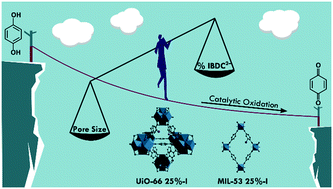Make room for iodine: systematic pore tuning of multivariate metal–organic frameworks for the catalytic oxidation of hydroquinones using hypervalent iodine†
Abstract
Iodine sites have been incorporated in both MIL-53 (Al) and UiO-66 (Zr) MOFs. A multivariate approach was used to increase the accessible area within the pores to allow for the catalytic oxidation of a model substrate, hydroquinone, to the corresponding quinone. In the process, three new phases of MIL-53 were discovered, one of which proved instrumental in allowing catalysis to occur. Both UiO-66 and MIL-53 with 25% incorporated iodine containing linkers allowed for a near-ideal balance between high density of catalytic sites and sufficient space for mass transport to enable catalysis to occur. Good conversions and selectivities were observed in nitromethane, ethyl acetate, acetone and ethanol with UiO-66 which proved to be the more active of the two catalysts. Oxone and 3-chloroperbenzoic acid acted as competent co-oxidants. X-ray photoelectron spectroscopy revealed that the reaction proceeded through an I(III) oxidation state. The MIL-53 framework was readily recycled while the UiO-66 MOF suffered from catalyst deactivation due to particle agglomeration. UiO-66 with 25% iodine containing linker proved to be a competent catalyst for a variety of substituted hydroquinones.



 Please wait while we load your content...
Please wait while we load your content...